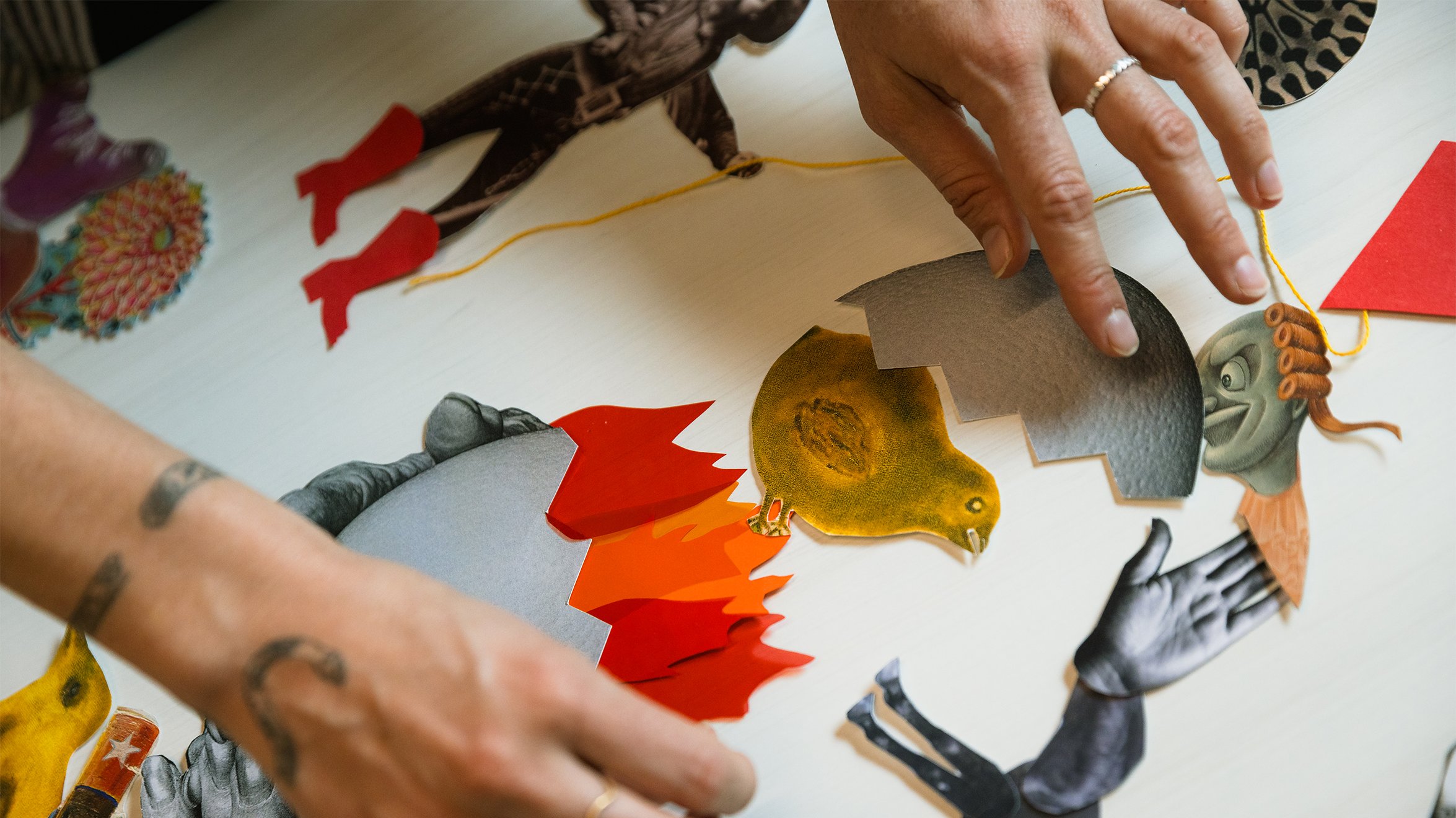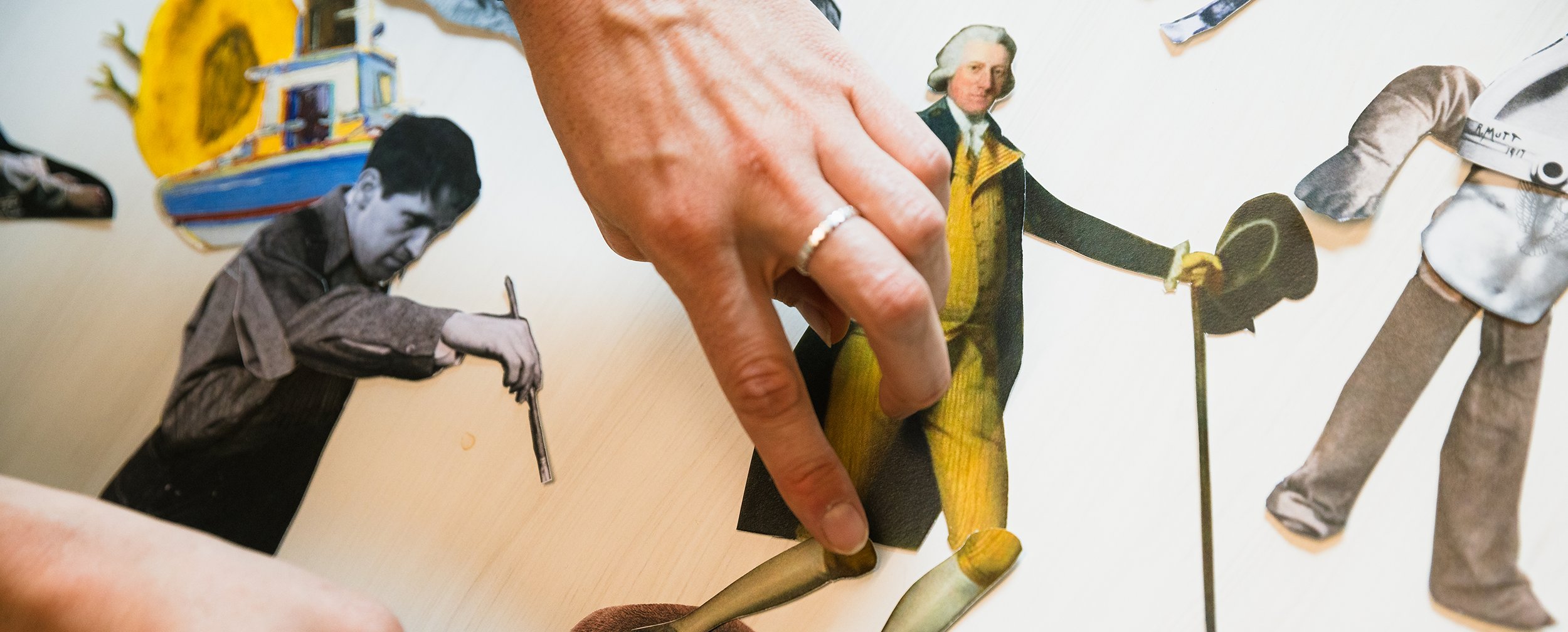
Making a Scene with Molly Murphy, Animation Assistant Professor with Motion Capture Background
10.27.2025
Assistant Professor Molly Murphy brings her interdisciplinary animation practice to KCAI, engaging students and the public in playful, collaborative explorations of movement and storytelling.
Assistant Professor of Animation Molly Murphy returns from Night/Shift at the Nelson-Atkins Museum of Art with a collection of two-dimensional puppets and cutout images. They’re now the stars of the evening’s collective creation: a 90-second stop-motion reel animated by visitors to Noguchi Court.
“The thing is, no one ended up needing our gamified help to get moving. People showed up full of ideas. We also had a bucket of prompts with different words, but people were really coming in with their own ideas for composition and movement,” Murphy says. “This made for a LOT of fun!”
People also had a general understanding of the process: by shifting objects little by little over time, you create the illusion of movement. The event, however, offered professional-level access with the tools and play set for participants to explore just how much they could (or couldn’t) accomplish.
The footage, rendered hourly by members of the KCAI Animation Department, resulted in a work reminiscent of Terry Gilliam’s animated sequences for Monty Python or the distinctive, collage-like pieces by Scorpion Dagger.
“It all took place in an art museum — a place I personally find soothing to be in,” Murphy says. “But at the same time, these spaces can have pretty exclusionary histories. Whether it be in the discrepancy of women artists featured to nude women portrayed or general representation issues, there's a lot in an art institution that can put people off.
“But this felt like a cool way to let the visitor be the artist. Rather than passively consuming, it gave a chance to remix the imagery of the museum. It was improv in real time but instead of making a film, you were making a scene.”
Interdisciplinary Absurdities
Molly Murphy (website here) is a new addition to KCAI’s Animation Department, bringing with her a practice increasingly rooted in performance. Her recent work includes motion capture, providing character movement for the Disney film Mufasa, directed by Barry Jenkins.
“I blocked out movement for a lot of characters but I was most recognized on set for Rafiki,” Murphy says, referring to the wise, mandrill shaman and royal advisor iconic to the film series. While the legendary John Kain voiced the character, she was the motion capture actor.
Originally, she came on as a previs animator, with her role evolving over time. She describes her work as becoming both a physical and virtual performance “Andy Serkis style.”
“While Mufasa is, of course, an animated film, its director came from live action. Part of what makes Barry's films so potent is the fact that they lean into improvisation and chance. Traditionally, this is pretty antithetical to animation,” she says.
To make the film work, she explains how they needed to find a way to make the process more interdisciplinary. Working under more legendary Hollywood VFX artists and engineers, Murphy played a part in bringing that animated set to life. Read more about the process here
"Part of what makes Barry's films so potent is the fact that they lean into improvisation and chance. Traditionally, this is pretty antithetical to animation."
“I was part of some initial motion capture stage tests where I would get in a suit and puppeteer lion and mandrill characters in real-time. Because I was working closely with the 3D character puppets, I had a unique mastery in the motion capture suit. I also love Barry's work so before every shoot I would hella study the stoicism and sensibilities that comes through in the performances he directs,” she says.
“It was an amazing opportunity to find ways to make animation more, as Barry said, ‘like jazz.’ That's the creative sweet-spot for me. The process was playful and hands-on. Especially when I got to play Rafiki,” she says.

That said, Murphy describes herself as an interdisciplinary filmmaker, cartoonist, and virtual production artist whose work explores shifting ecosystems and the absurdities of the human condition. Empathy is central to her approach, guiding her to seek out the perspectives of marginalized communities and engage in direct collaboration with them.
Her cartoons and illustrations have been featured in The Atlantic, The New Yorker, and The Rumpus, while her animations have screened at international festivals such as Palm Springs ShortFest, Northwest Film Fest, La Guarimba, and the Calgary Underground Film Festival. Her practice has been supported by grants from the Sloan Foundation, Breakthrough Science Foundation, and the MacDowell Fellowship.
This semester, Murphy is teaching the Junior Seminar in the Animation Department, co-teaching with John Baker and Heather Rodgers. “I feel like I’m able to grow as a teacher much faster this way. I was teaching grad students before, so it's my first time working with such young adults. I love learning about the way they see the world. They're hungry to create and it's really exciting to see.”
Next semester, Murphy will teach the 3-Dimensional Animation course and is still finalizing her elective offerings. She is also adjusting to life in the Midwest after spending most of her career in California. Prior to KCAI, she taught in the Expanded Animation program at the University of Southern California.
“It’s quite a leap to land here,” she says. “But it has been such a great opportunity. Till now, I've only lived in big coastal cities so I feel well outside my comfort zone here. But in some ways, it’s liberating.”
Playful Improvisation
That is part of what excites her about the recent collaboration Nelson-Atkins Museum. “It feels low-budget relative to the kind of work we did on Mufasa. It's playful, it's improvisational, and you don't have to be an animation expert to play part in it.”
On her desk, she positions tiny flamboyant boots on a stuffy aristocratic puppet. Nearby, a fire of orange and yellow paper sheets emerges from a flat, cracking egg. These readymade assets are meant to get the gears turning for the public and offer a glimpse into the care and attention behind each individual frame.
It’s an enormous effort, not undercut but energized by Murphy comparing the stance of a vintage cowboy cutout to Saturday Night Fever.